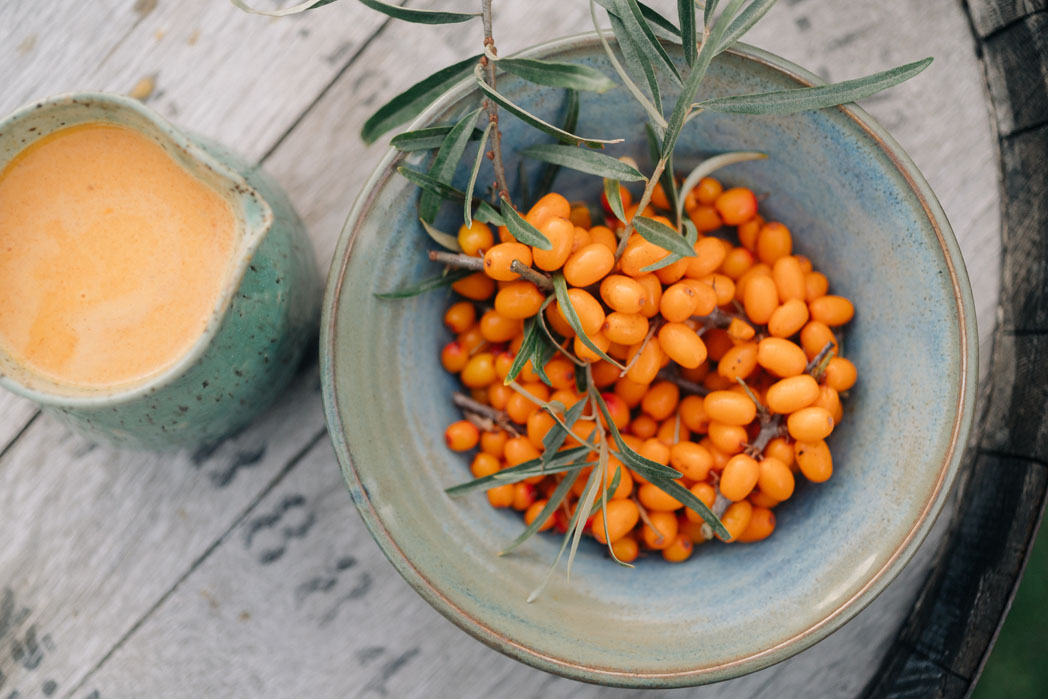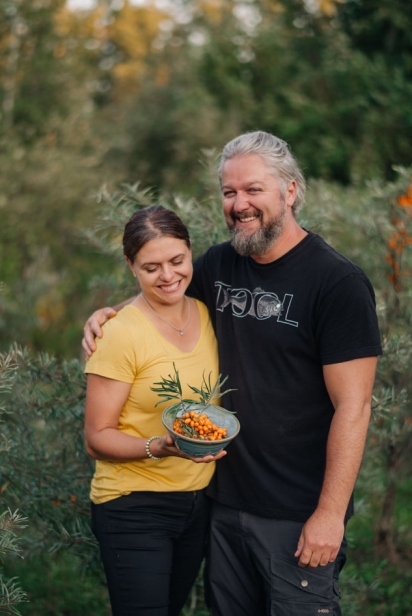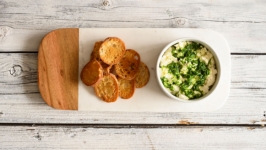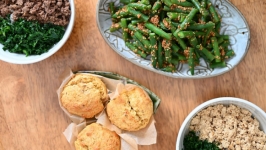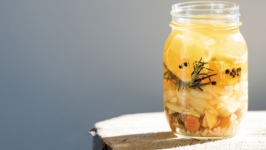Northern Citrus
With silvery leaves and a tousled, fresh-out-of-bed appearance, the sea buckthorn bush doesn’t look as though it might produce one of nature’s most nutrient-dense berries. Packed with protein, vitamins C, E and K1, carotenoids, phytosterols and essential fatty acids, the vibrant yellow-orange sea buckthorn berry, also known as the Siberian Pineapple or Sandthorn, has been making a name for itself in Canada.
Apart from any gustatory, nutritional, pharmaceutical or topical benefits, it’s hardy. There’s simply no point in fighting nature, where the climate sees temperatures dip below minus 20 C in winter and above 30 C in the summer. But the sea buckthorn is just fine with that. It’s also remarkably tolerant of poor soil and minimal moisture, and that makes it a winner right out of the gate.
“It’s a weird and wonderful plant,” says Giselle Cardinal, a sea buckthorn farmer who cultivates 150 bushes with her partner Nikola Mraovic, on a farm near Vars, to the east of Ottawa. “There are both male and female plants and you need both for pollination. One male plant, which produces tiny pine cones, can pollinate up to seven females. The pollen, which is like finely grated lemon rind, blows on the wind.”
The bushes, which look like a cross between an olive tree and a willow, are native to the Atlantic coasts of Europe, spreading east across Norway, Finland and Russia, to northwestern Mongolia and northwestern China. Recognized for centuries for its nutritional benefits, the Hippophae family of plants (there are several varieties) were used by the Greeks to feed horses to promote weight gain, good condition and a glistening mane. Hippophae literally means “shiny horse.”
Sea buckthorn starts to produce fruit after its third season and can do so vigorously. Some grow as tall as 20 feet, “so we harvest the branches, laden with berries, with a giant, ride-on hedgecutter,” Cardinal says. “We trim the heaviest laden branches and put them straight in the freezer, or they stay fresh for about three weeks. The rest we harvest by hand and it takes about two hours per tree. Every part of the plant is edible.”
But it’s the berries that pack a punch. They’re tiny — smaller than a plump blueberry — yet by volume they have 50 times the vitamin C of an orange. Just eight berries will provide your daily allotment of the vitamin. It’s one of the most vitamin-rich foods known to chefs, scientists and aficionados, and is increasingly widely available as juice, oil and in fresh berry form.
“It’s naturally very citrusy and sour like lemon, lime or grapefruit,” Cardinal says. “It’s good with smoked salmon, because it cuts the fat and also good in soups and salad dressings.”
The berries can also be used to make ice cream, teas, jams, jellies, chutneys, pies and processed to use topically in skin creams. When the fruit is pressed, it separates into three layers. On top is a thick, orange cream; in the middle, a layer containing sea buckthorn's saturated and polyunsaturated fats; and the bottom layer is juice and sediment. Sea buckthorn juice is widely available in Germany and Scandinavian countries and was first produced in China.
“Sea buckthorn is an amazing little fruit that is packed with a ton of flavour. It has this incredibly vibrant colour that can really add an amazing visual dimension to the plate,” says Ottawa-based chef, Dipesh Parmar.
“I really enjoy working with local products and farmers, so when Giselle brought me her sea buckthorn I wanted to showcase it in a dessert. I originally thought about a take on a lemon meringue pie, but didn’t want to overpower the taste of the sea buckthorn with all that sugary meringue. So, I made a sea buckthorn curd and paired it with a lightly sweetened yogurt and white chocolate crumb. This gave some balance to the tart while allowing that sea buckthorn to still be the focus and the main flavour. The creaminess of the yogurt and the sweetness of the white chocolate help to balance out the tartness of the sea buckthorn.”
Parmar also uses the fruit in other ways, such as gelées for desserts, vinaigrettes, smoothies and juices, BBQ sauces, and hot sauces. “We use them in different ways to play with the fruitiness or acidity of the dish,” he says.
Over the river at Les Fougères in Chelsea, Quebec, Gold Medal Plates winning chef Yannick Lasalle uses sea buckthorn widely.“I love this tart northern berry because of its distinctive flavour. It’s also a super food because of its high vitamins and it’s one of the last berries harvested at the end of summer,” he says.
Lasalle uses it in sweet dishes, such as a panna cotta with maple syrup and tangerine meringue, and also in his dish presented to the judges in the grand final of the Gold Medal Plates championship in Kelowna: a plate of cured duck prosciutto, local fennel, sea buckthorn and Quebec saffron.
Cardinal planted her first bushes in the fall of 2015 after a chance encounter in the shower. “It’s all because of a Wileda body wash,” she says. “It was grapefruit and sea buckthorn and it smelled like heaven. It had a weird name and it snowballed from there, really.”
The farm has grown slowly and steadily. “At the time nobody was growing them in the Ottawa region. I decided I wanted something low maintenance,” she says of the fruit that she now sells to restaurants such as Beckta and ice cream-maker Moo Shu and to the general public.
This year, Hedgerow Orchard will be offering curb-side delivery to your car door. In this way, you won’t have to brave the gnarly thorns that sometimes make picking sea buckthorn an uncomfortable experience. The season runs from Aug. 15 to mid-September for fresh berries, depending on rain and heat, but Cardinal has frozen berries for sale now.
Hedgerow Orchard
facebook.com/organicseabuckthorn | @hedgeroworchard
hedgeroworchard@gmail.com
Cultivating sea buckthorn
The high nutritional value of sea buckthorn berries and their tart citrus flavour are reason enough to plant a few shrubs of your own, but cultivating these fruit-bearing perennials also offers a host of other benefits:
• The woody shrub can grow in hardiness Zone 3 (Eastern Ontario is Zone 5) with temperatures as low as -40C.
• According to the Ontario Ministry of Agriculture, Food and Rural Affairs' website, the hardy shrub can quickly develop an extensive root system, capable of fixing nitrogen levels in the soil over time, which can help other plants grow. They also help control soil erosion.
• The shrubs like full sun and can grow in marginal soils, but thrive in welldrained sandy loam. They can also be drought-tolerant, but yield the most fruit with 400 millimetres of annual precipitation (Ottawa has more than enough).
• Sea buckthorn blossoms offer an early source of pollen and nectar for pollinators and are a favourite habitat of nesting birds.
• Just remember that sea buckthorn shrubs are dioecious, meaning separate male and female plants are required for pollination.


